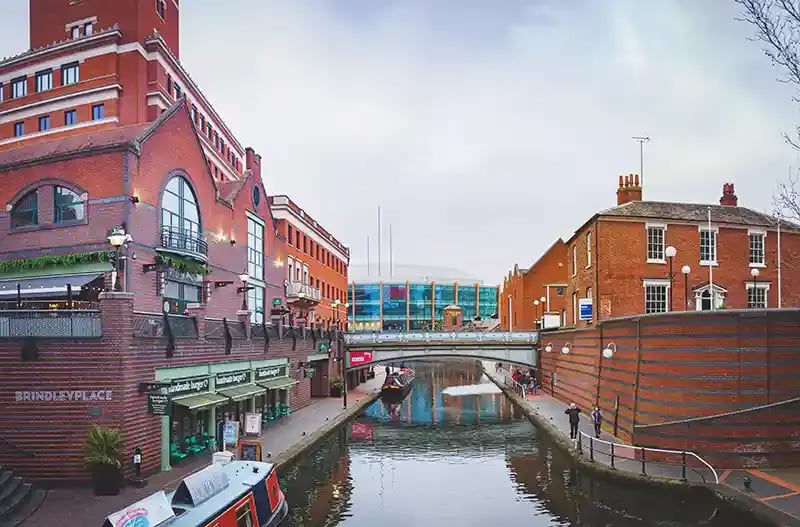In our recent Regional Market Report: The Midlands, we looked at how the East and West Midlands were performing in terms of housing delivery.
As the UK’s second-largest city, we wanted to give Birmingham more time in the spotlight – examining how the Local Planning Authority (LPA) is performing, and looking at the impact this is having on the creation of new homes.
For more data-driven insights into The Midlands download our Regional Market Report.
Housing delivery in the region
From 2017 to 2018, the West Midlands delivered 22,193 new homes. This figure increased by 10.8% in the period from 2021 to 2022, when 24,593 additional homes were built in the area.
And over 5 years, 115,047 new homes were delivered – or 3.87 new homes for every 1,000 people.
When we look at the historic pace of delivery alongside the projected population, we calculated that 24,580 new homes need to be built each year in the West Midlands in order to match up with the estimated levels of demand.
On an individual LPA level, the top five performers in terms of the amount of net additional homes added per 1,000 people were:
- Walsall: 9.77
- Stratford-on-Avon: 9.65
- Rugby: 8
- Wychavon: 6.99
- Telford and Wrekin: 6.32
Now, let’s take a closer look at how Birmingham performed.
Birmingham’s housing market
Housing delivery in Birmingham
Taking that same net new home data but only focusing on Birmingham, we can see that more new homes were built in Birmingham than in any other LPA in the West Midlands in 2017-2018 and 2021-2022 (3,160 and 3,177 respectively).
This is unsurprising considering the size and population of Birmingham. But if we look at new homes added per 1,000 people, this equates to 3.11 new homes – lower than the West Midlands as a whole. And the ninth lowest out of any LPA in the region.
So, what could be causing this lower (comparative) rate of delivery?
The data we pulled for our Midlands report throws up some interesting ideas.
Determination periods for planning applications in Birmingham
We’ve used our own data to analyse the average determination period for different types of development, excluding ‘extensions of time’. This has been done by calculating the number of weeks there are between the validation date on a planning application and the determination date of that application.
Non-major applications are supposed to be decided within 8 weeks, but this often isn’t the case.
Despite Birmingham City Council being among the best performers in the Midlands region for planning application determination periods, from 2018-2021, determination periods consistently averaged over 8 weeks for non-major applications. Only in 2022 did we see this figure sit where it needs to be at 7.5 weeks.
For major applications (expected to be decided within 13 weeks, or 16 weeks if the application is EIA development), the results are better. Apart from 2020 (averaging 15.71 weeks), the average decision times in Birmingham from 2018-2022 was under 13 weeks.

Planning application approval rates in Birmingham
Approval rates are a good indicator of an LPA’s appetite or ability to deliver new housing in the area.
Birmingham’s residential approval rate was lower than a lot of other LPAs in the West Midlands for non-major applications – reaching its lowest point in 2020 with only 54% of applications being approved. Since then, approval rates have trended upwards, and in 2022 they were at 64%.
Coventry makes a good point of comparison as it’s close geographically and the second most populous city in the West Midlands. From 2018 to 2022, Coventry’s approval ratio for residential non-major applications has not dipped below 74%.
The results for major residential applications are slightly higher in Birmingham with the approval ratio never lower than 60%. In 2022, it was 67% compared to Coventry’s 91%.
Green Belt land in the West Midlands
Compared to the South East, the Green Belt isn’t as much of an issue for developers. But, the West Midlands Green Belt does still take up a significant chunk of land in some LPAs.
13.9% of Birmingham’s total area is taken up by Green Belt land so it causes development restrictions on a hefty percentage of land. This will be particularly challenging if the proposed changes to the National Planning Policy Framework go through, although currently these changes - like a lot of the Government’s planned reforms to the planning system - are shrouded in a stifling uncertainty.
Future housing delivery in Birmingham
Birmingham is delivering new homes. In fact, they significantly exceeded the targets outlined in the Housing Delivery Test from 2019 to 2021.
But like with every growing city, more new homes are always needed.
Birmingham’s City Plan calculates their housing need at 7,136 dwellings per annum.
There are a number of schemes outlined in the Plan aimed at boosting housing delivery, such as:
- The Central Birmingham Renewal Framework – reimagining and redeveloping certain central zones to unlock opportunities
- Improve public transport links – increase the appeal of certain areas by making them more accessible
- Engage with local communities – find out where new housing is needed the most
On top of these things, the council needs to work to shorten determination periods and increase approval rates on feasible residential planning applications to deliver the amount of housing needed to meet future demand.
For more data-driven insights into the housing market, demographics, and the planning system, download our Regional Market Report: The Midlands here or register below to catch up on our on-demand webinar – Market Overview: The Midlands.
Register here:
Here’s some other content you might be interested in:
